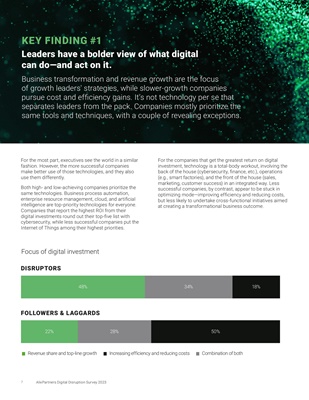
7
AlixPartners Disruption Index 2023
Introduction
Companies can create digital disruption, not just react to it
That makes it different from forces like demographic or
climate change, the retreat from globalization, geopolitical
events, or macroeconomic cycles, which are largely out of
the control of any one company. Digital is also unique in that
almost all companies have a department dedicated to it-a
team with a budget, a plan, a mission, and a leader. Digital is a
day-to-day management responsibility as well as a long-term
strategic wildcard, a function as well as a force. Companies
must keep their digital shop running even as what it does
changes with the speed of Moore's Law.
In other words, companies need to manage their digital
assets and processes as securely as if they were operating
a nuclear power plant, while also having the flexibility and
creativity to lead-or leapfrog-when new opportunities
appear. Thus, while 75% of respondents say that fastchanging
artificial intelligence technologies will be very
important in their industries, 30% also say that failure to
consider cybersecurity is a major reason technology projects
do not achieve their goals.
The companies that accomplish the difficult task of
combining innovation with rock-solid execution share several
characteristics. First, they let business outcomes drive digital
investments. Yes, they're up on the latest technology-indeed,
often they adopt it early-but they don't let shiny objects
distract them from the goal of creating enterprise value.
Second, their technology and business leadership are closely
integrated and have a high level of mutual trust, a confidence
that extends beyond managing technology to include
collaborating to create and deliver greater value creation.
Third, they have scale. The IT industry celebrates a born-ina-garage
mythology; but larger companies are more likely
to tell us they lead digital disruption. Perhaps this is because
size allows them to absorb a shock; perhaps because it
allows them to experiment with, invest in, and roll out new
technologies with enough power to make a difference in their
markets, or both.
The digital stakes keep going up. Companies that turn
digital's disruptive power to their advantage beat their rivals
on key measures of growth, profitability, and value creation.
Disruptors are also increasing their digital investments while
laggards, on average, are not.
Disruption shakes things loose. It upends plans. It fills some
profit pools and drains others, often in unexpected ways. It
rattles relationships with customers, and as the center of
gravity and value creation within an industry shifts, business
models must change, too.
It's clearly better to be source of disruption than to have to
react to it. Companies that drive disruption are far more likely
to be growth leaders in their industry; and 51% of companies
that respond reactively to disruption trail their competitors
when it comes to growth. (See exhibit.)
Disruptors lead their Industries in growth
When it comes to growth, how would rank your company?
Disruptors Followers Laggards
Somewhat
or significantly
behind
In the middle
of the pack
Among the
leaders
Setting the
pace in our
industry
1%
21%
59%
7%
67%
26%
51%
41%
6%
0%
16%
75%
of Disruptors are
leading in growth
Disruptors believe digital investments
will be major drivers of continued growth
Disruptors Followers Laggards
70%
10%
20%
30%
40%
50%
60%
Expect significant or extreme growth
from digital investments
0%
Disruptors lead their Industries in growth
When it comes to growth, how would rank your company?
Disruptors Followers Laggards
Somewhat
or significantly
behind
In the middle
of the pack
Among the
leaders
Setting the
pace in our
industry
1%
21%
59%
7%
67%
26%
51%
41%
6%
0%
16%
75%of Disruptors are
leading in growth
Disruptors believe digital investments
will be major drivers of continued growth
Disruptors Followers Laggards
70%
10%
20%
30%
40%
50%
60%
Expect significant or extreme growth
from digital investments
0%
GRAPH BEING DELETED